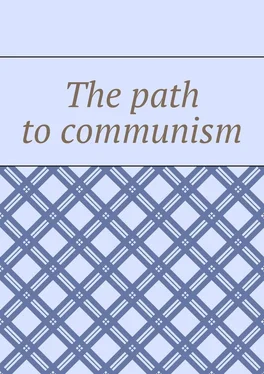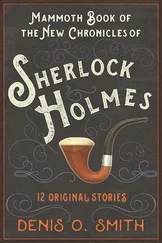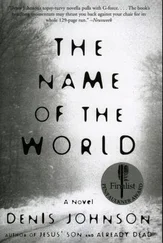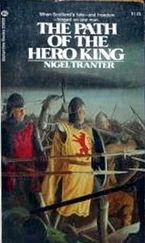Denis Burenko - The path to communism
Здесь есть возможность читать онлайн «Denis Burenko - The path to communism» — ознакомительный отрывок электронной книги совершенно бесплатно, а после прочтения отрывка купить полную версию. В некоторых случаях можно слушать аудио, скачать через торрент в формате fb2 и присутствует краткое содержание. ISBN: , Жанр: Политика, на английском языке. Описание произведения, (предисловие) а так же отзывы посетителей доступны на портале библиотеки ЛибКат.
- Название:The path to communism
- Автор:
- Жанр:
- Год:неизвестен
- ISBN:9785005304308
- Рейтинг книги:4 / 5. Голосов: 1
-
Избранное:Добавить в избранное
- Отзывы:
-
Ваша оценка:
- 80
- 1
- 2
- 3
- 4
- 5
The path to communism: краткое содержание, описание и аннотация
Предлагаем к чтению аннотацию, описание, краткое содержание или предисловие (зависит от того, что написал сам автор книги «The path to communism»). Если вы не нашли необходимую информацию о книге — напишите в комментариях, мы постараемся отыскать её.
The path to communism — читать онлайн ознакомительный отрывок
Ниже представлен текст книги, разбитый по страницам. Система сохранения места последней прочитанной страницы, позволяет с удобством читать онлайн бесплатно книгу «The path to communism», без необходимости каждый раз заново искать на чём Вы остановились. Поставьте закладку, и сможете в любой момент перейти на страницу, на которой закончили чтение.
Интервал:
Закладка:
The path to communism
Compiled by Denis Burenko
ISBN 978-5-0053-0430-8
Created with Ridero smart publishing system
INTRODUCTION
Hello dear person! I see that you are not indifferent to the fate of your country, since you are now reading these lines. Me too! Since you are reading these lines, then surely not everything is so smooth in your state. And you want to change this world. You want democracy to reign in your country, social justice to be present, so that the level of well-being of the population is at a high level. Fortunately, I am not the only one who has tried to do this. I have a certain “food” on which I am writing these lines. Karl Marxand Friedrich Engelsoverturned the idea of the laws of development of nature and society. They were able to prove that the most important causes of social contradictions are not related to cultural, linguistic and geographical differences, as bourgeois ideologists claim. The development of society depends primarily on who owns large property and the means of production, how the owners dispose of them, and how equitably the wealth created by labor is distributed. It is economic relations that determine all aspects of human life: politics, law, the state and its institutions, culture, ideology, religion, art, worldview and morality. Vladimir Leninwas able to test this in practice, proving that these are not utopian ideas, but real prospects, having implemented the socialist revolution, and thereby establishing the rule of the proletariat(working class). Now in the world there are two main economic systems: antisocial (aimed at oppressing the majority of people) and social (aimed at the domination of social justice for all people and excluding the exploitation of other people’s labor). In this book, we will describe the historical development of society. We will prove that the main principle of the antisocial system of the economy is the exploitation of man by man = social inequalityhas always been and is. And with the” peaceful economic modernization of the antisocial system of the economy” continued to exist. But the principle of the social system of the economy from each according to his ability to each according to his work = social equalityis a principle that is possible only with a revolution. And not in a bourgeois-democratic revolution, but in a proletarian(people who make (workers and peasants)) revolution. All these “scientific expressions” incomprehensible to us, like: socialism, capitalism, democracy, revolution, classes: the proletariat and the bourgeoisie and others, we will analyze in the course of our research.
Chapter 1. Primitive society
Primitive society is the longest period in the history of mankind. Scientists believe that the distant ancestors of modern humans appeared more than two million years ago. Ancient people lived in conditions of a primitive human herd. A modern human was formed about 40 thousand years ago.
The accumulation of production experience by ancient people and the improvement of labor skills led to the creation of a new type of labor tools, with the help of which it was possible to chop, cut, saw, drill. Drilling and grinding of stone contributed to the creation of combined tools (stone ax, spear with a sharpened flint blade). The invention of the bow and arrow dramatically increased the efficiency of hunting, made it possible for individual hunting for small animals. The meat obtained in the hunt becomes a constant human food. This played an important role in strengthening the settled way of life and contributed to the gradual transition to a production-type economy. At the same time, the domestication of wild animals began.
The social organization of primitive society was a clan community,uniting a group of relatives. The community had collective propertyand was engaged in farming on the basis of the gender and age division of labor. Moreover, the leading role in the community belonged to women. They were engaged in gathering, cooking, keeping the home and raising children. The clan was the main socio-economic unit of the primitive communal society.A genus is an association of people of a modern physical type, a consolidated production team with complex and diverse social ties, which contributed to the acceleration of the development of material and spiritual culture, a significant increase in the rate of development of the productive forces of primitive society.
Agriculture and animal husbandry were primitive in nature. Hoe farming required a huge investment of time and hard work from people. However, agricultural and pastoralist tribes developed more dynamically than the tribes of hunters, fishermen and gatherers. Agriculture and cattle breeding led to an increase in production volumes. People began to procure food supplies, received constant sources of food, which qualitatively changed their living conditions. During this period, the population increases.
Agriculture was born out of gathering. Improving production, people moved from hoe farming to arable farming. They used such farming systems as swap, slash-and-burn, cultivated crops on irrigated and non-irrigated lands. East Asia became the focus of agriculture, where, under favorable climatic conditions, agriculture developed in river valleys. In the steppe, semi-desert and desert regions, nomadic cattle breeding prevailed. The economic activities of people became more and more diverse. People began to engage in woodworking, build houses and boats. The simplest type of loom appeared. People learned to sculpt utensils from clay, weave nets, and use the draft force of animals to move goods. In the IV millennium BC. the potter’s wheel and wheel were invented. Wheeled carts appeared.
So, how were the most important decisions for the tribal community made? As we have said earlier, the economic relations determine all aspects of human life. This means both the social well-being of the tribal community and social equality depend on the form of ownership of the means of production. As we have already said, the region had collective property and was engaged in the economy on the basis of the gender and age division of labor. What is collective property? And what place do people who produce and work occupy in it? Collective property is a form of ownership in which all members of the collective have equal rights to its ownership and use, as well as to equal participation in the disposal of the results of labor. Accordingly, such an economy can be called commandor planned.
The management and power of the clan community belonged to the general assembly of the clan – the supreme governing body. The elder is the oldestand most experienced member of the clan community. His power was provided by his life experience, knowledge of traditions and customs. Elder directs silt hozyays Twain and social life of the tribal community, allowed the debate within the genus.
The normative regulation of the tribal community was: customs, moral norms, religious norms, taboos, myths.
Thus, a primitive society can be called a society where direct democratic socialismprevailed. Direct democracy is a form of political organization and structure of society, in which the main decisions are made and executed directly by citizens. This was really so, since, as we have already said, the management and authority of the clan community belonged to the general assembly of the clan. The general meeting is understood as the meeting of all members of the clan. Decisions were taken by a majority vote. So this “direct democracy” was in primitive society, and we have proved it.
Читать дальшеИнтервал:
Закладка:
Похожие книги на «The path to communism»
Представляем Вашему вниманию похожие книги на «The path to communism» списком для выбора. Мы отобрали схожую по названию и смыслу литературу в надежде предоставить читателям больше вариантов отыскать новые, интересные, ещё непрочитанные произведения.
Обсуждение, отзывы о книге «The path to communism» и просто собственные мнения читателей. Оставьте ваши комментарии, напишите, что Вы думаете о произведении, его смысле или главных героях. Укажите что конкретно понравилось, а что нет, и почему Вы так считаете.












